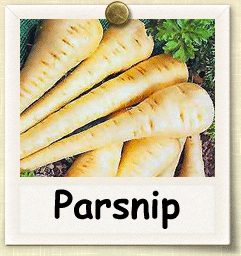|
Home > Guides > Vegetables > Parsnip |
|
How to Grow Parsnip | Guide to Growing Parsnip |
|
|
|
|
| |
 |
|
Overview |
|
|
|
|
|
| |
|
| |
Perhaps the hardiest of all garden crops, parsnips don’t develop their sweet, nutty flavor until after enduring frosts and cold weather in fall. Can be overwintered for harvest as soon as soil thaws in spring. |
|
| |
|
|
| |
|
|
| |
|
|
10 to 21 days, 50F to 85F |
|
|
|
|
|
|
|
|
|
|
|
|
|
|
|
|
|
|
|
|
Growing Guide
GROWING NOTES
Yields best in full sun.
Prefers well-drained, loose, fertile soil, free of stones pH 6.0 to 7.0. Heavy clay soils may cause crooked and branched roots. Needs a fair amount of moisture.
Biennial grown as an annual.
Requires deep, well-prepared soil, early planting, and good early weed control.
Leaves arise from spherical swollen stem.
MAINTAINING
Sow seeds ½ inch deep, 1 inch apart, in rows 18 to 24 inches apart, in early spring. Seeds germinate slowly, usually in about 2 to 3 weeks (longer in cold soils). To speed germination, keep soil moist. Sow along with radishes to break soil crust and mark row.
Thin to 3- to 4-inch spacings. Trim instead of pulling to avoid disturbing roots of remaining plants.
Mulch to suppress weeds and retain moisture.
Hill soil around base of plants to prevent greening of root shoulders.
|
|
| |
|
| |
Heirloom seeds are the gardeners choice for seed-saving from year-to-year. Learning to save seeds is easy and fun with these books. Before you harvest, consider which varieties you might want to save seeds from so that your harvesting practice includes plants chosen for seed saving. Be sure to check out our newest seed packs, available now from Heirloom Organics. The Super Food Garden is the most nutrient dense garden you can build and everything you need is right here in one pack. The Genesis Garden s a very popular Bible Garden collection. The Three Sisters Garden was the first example of companion planting in Native American culture. See all of our brand-new seed pack offerings in our store.
|
|
| |
|
|
| |
Harvesting Guide
HARVESTING
If you want really good tasting parsnips, and they're ready, dig some out right before the first frost. While some people think it's better to wait till just after, I and many others think they're better tasting harvesting them right before the first frost. The sugar which gives parsnips its flavor, and comes from conversion from its starch, is released as the weather becomes colder.
To keep root damage to a minimum, use a fork spade to dig under and root them out.
Decide how many parsnips you want for the near future, and you can just keep them over winter in the ground. Put about four to six inches of mulch over them to keep them in good condition in the soil. The roots of parsnips are not damaged by the soil freezing.
Do be sure to harvest the parsnips before the ground gets too hard and difficult to work with.
If you do keep some in the ground over winter, harvest them before the new growth emerges in the early spring.
You can store parsnips in a cool place for up to six months. In a refrigerator, normally two months is the maximum they last.
SAVING SEEDS
Parsnips make tall flower-heads of little yellow flowers in their second year, soon followed by huge numbers of papery seeds.
Leave a good number of only the very best and biggest roots in the ground overwinter for your seed crop,
otherwise you'll be keeping seed that tends to make small parsnips.
And pull up any that start to flower long before the others, you don't want to develop a strain that has a tendency to bolt!
You can only let one variety go to seed each year, as they cross easily. Other than that, parsnip is very easy to save seed from, and you'll get much better seed than you can buy - it doesn't keep or store well at all.
Radish and turnip also produce seed in their second year, so the process is similar.
|
|
| |
|
|
|
| |
|
|
|
|
|
| Click the packs below to see some of our other wonderful products |
|
|
|
|
|
|
|